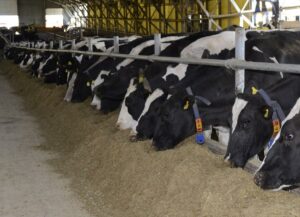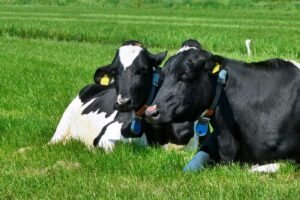Fernando Diaz
A large amount of different corn co-products is produced every year. Corn kernels are refined either by wet milling or dry-grind processing. Corn gluten feed is a co-product of the wet milling process in which starch is converted to sweetener (fructose). Approximately, 24% of the original grain is recovered as gluten feed, and this contains mainly corn bran and corn steep liquor. Its high content on digestible fiber and protein makes corn gluten feed a valuable energy and protein source for lactating dairy cows.
In a recent study conducted at the Ohio Agricultural Research and Development Center, The Ohio State University, Weiss (2019) evaluated the effect of replace concentrate in a conventional diet with corn gluten feed on lactation performance of Holsteins dairy cows (91 to 135 days in milk). The diets contained the following ingredients:
- The conventional diet included 37% corn silage, 18% alfalfa silage, 24.3% corn grain, 13% soybean meal, 4.9% soyhulls, 0.5% fat plus 2.3% mineral and vitamin supplement in a dry matter (DM) basis.
- The corn gluten diet contained 53.2% corn silage, 44.0% corn gluten feed plus 2.8% mineral and vitamin supplement.
The table below shows composition of corn gluten feed and silages used in the experiment. Protein, starch and fiber (NDF) content in gluten feed were 21.4, 9.4, and 36.7% DM, respectively.
| Nutrient | Corn gluten feed | Corn silage | Alfalfa silage |
| Dry matter (%) | 68.2 | 36.5 | 50.3 |
| CP (% of DM) | 21.4 | 7.2 | 20.6 |
| NDF (% of DM) | 36.7 | 41.7 | 45.5 |
| Starch (% of DM) | 9.4 | 32.8 | – |
| Long-chain fatty acids (% of DM) | 2.2 | 2.5 | 2.1 |
| Ash (% of DM) | 6.9 | 3.7 | 11.6 |
| NDF Digestibility 30 h (% of NDF) | 75.8 | 52.0 | 42.4 |
Protein and metabolizable protein (MP) concentration was similar between diets (16.0% and 10.9% DM). However, lysine concentration (6.01 vs. 6.46 % MP) were lower in the gluten feed diet. Rumen undegradable protein, estimated in vitro, was 30% lower in the gluten diet (5.2% DM) than the conventional diet (7.6% DM). Compared with the conventional diet, fiber concentration was greater (38.3 vs. 31.3% DM) and starch content was lower (21.6 vs. 30.8% DM) in the corn gluten-based diet.
The researcher reported that feed intake was similar in both diets (24.1 kg/day). However, in cows fed the conventional diet daily milk production was 2.3 kg greater (38.1 vs. 35.8 kg/day). Although milk fat (3.70%) and protein concentrations (3.11%) were similar between diets, cows fed the conventional diet produced more milk fat (1.39 vs. 1.32 kg/day) and milk protein (1.18 vs. 1.10 kg/day). In addition, milk urea nitrogen was considerably higher in the cows that received the gluten diet (14 vs. 12 mg/dL).
Feeding the corn gluten feed diet decreased milk lactose content (from 4.78 to 4.67%) which was associated with a reduction in lactose yield of 150 g/day. The lower levels of starch and essential amino acids in this diet may have limited precursors for lactose and milk synthesis.
Although feed efficiency was 4.5% greater in cows that received the conventional diet; body weight gain was lower in this diet compared with the corn gluten feed diet (50 vs. 600 g/day). Despite energy supplied by the two diets was similar, cows fed the gluten-based diet partitioned more energy toward body reserves at the expense of milk production.
In conclusion, the results of this study show that feeding lactating diets with high inclusion of corn gluten feed reduces production performance compared with multi-ingredient diets. Further experiment is warranted with lower inclusion rates.
Reference
Weiss, B. 2019. Effects of feeding diets composed of corn silage and a corn milling product with and without supplemental lysine and methionine to dairy cows. J. Dairy Sci. 102:2075–2084.
© 2019 Dairy Knowledge Center, LLC. All Rights Reserved.











